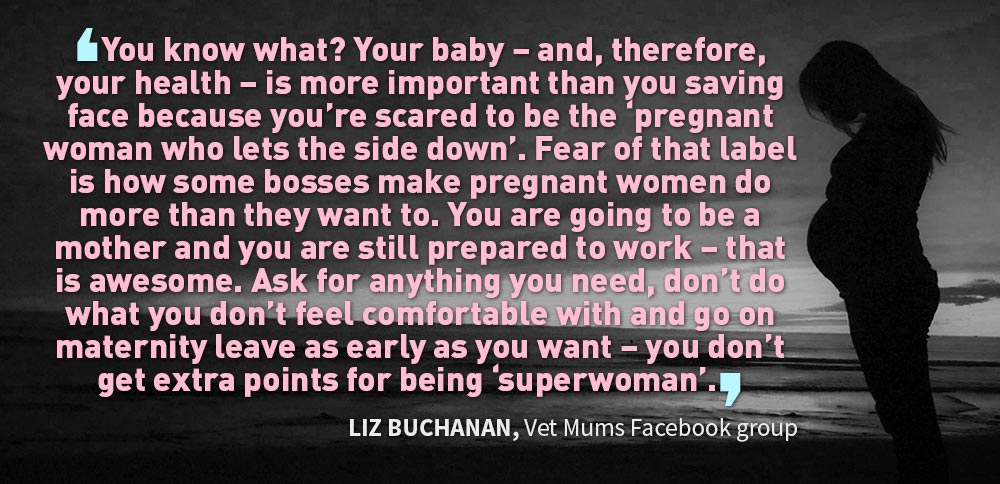3 Feb 2018
The changing gender balance of the profession has increased the number of vets who are juggling parenting/work trade-offs. Liz Barton explores the challenges and opportunities experienced by parents, employers and the veterinary sector in balancing family and vocation.

Image © Elnur Amikishiyev / Adobe Stock

I am a vet and a mum – and, most recently, curator and creator of resources for vet parents on the Vetsnet resource hub. I am also an administrator of the Vet Mums Facebook group.
I write from my own experiences, that of friends and colleagues, and the conversation threads explored on Vet Mums. If you have anything to add or contribute, please get in touch.
Let’s begin with conception. For some, this natural phenomenon comes too easily and brings with it the emotional challenge of undertaking a pregnancy, without the benefit of having planned or necessarily wanting to celebrate the fact.
For others, the opposite is true. Many of us will have been reminded of the ticking biological clock and know what it feels like to be asked: “When are you planning a family?”, or the old chestnut: “You’re not getting any younger.”
It can be horribly grating when your brain is already buzzing with the timing of your cycles, and reducing stress and alcohol intake (subtly, so people don’t notice).
Plus there’s the awkwardness of asking for time off for IVF treatment, the hormone swings, and the pressure from family and yourself. Thankfully, awareness and support groups are growing.
52 weeks – the amount of maternity leave you are entitled to.
39 weeks – the amount of maternity leave that qualifies for statutory maternity pay. The first six weeks of maternity pay is calculated as 90% of average earnings, which is based on the two months leading up to the qualifying week (the 15th week before your due date), while the remainder is £140.98 per week or 90% of average weekly earnings – whichever is less.
15th week before the week your baby is due – the time by which you must tell your employer you are pregnant.
28 days – the amount of notice you have to give before starting maternity leave.
11 weeks before the expected week of childbirth – the earliest you can start maternity leave.
It is not uncommon to wait until you have had your first scan results and the greatest period of risk has passed before announcing your news to the world.
It is also the time of most intense organogenesis, when the little bean is most susceptible to damage. Therefore, in our profession, it may be best to confide early in a trusted employer or colleague who will help you avoid chemotherapy, physical injury, hormone injections, anaesthetics, cleaning agents and radiography (pregnancy lead aprons are available for vets who work in the field).
Then there are the symptoms, such as morning sickness. While I was spared hyperemesis gravidarum, I was disappearing between operations to vomit 10 to 12 times a day. Never has a smile and the phrase “I’m fine” been so hard to say day after relentless, nauseous days – I will never feel the same way about ginger – not to mention sleeplessness, polyuria and achy boobs. Changes to mind and body can be extreme.
Despite all this, we often put ourselves under pressure to be every bit as capable as we were before pregnancy. It is not an illness – it’s a natural state, so surely it should come to us naturally and we should be every bit the neurotic, perfectionist pregnant vet as ever.
But it’s okay not to be okay; to put you and your baby first. Your body is working for two – in fact, it’s mainly working for your baby, at your expense – so give yourself a break. We all know friends who have sailed through pregnancy, but most of us struggle at times.
You can help yourself in many ways – eat well, sleep well, take proper breaks, exercise regularly and read a good maternity book or blog for reassurance. This is all entirely normal.
Join an online community, such as Vet Mums, BEVA MumsVet or more general sites, such as Netmums or Mumsnet (the former set up by a group of mums to inform about local resources, the latter set up by journalists with lighter moderation).
Remember, self-care in this period is also caring for your baby, so not “self-ish”. Nap in your lunchbreak (take an eye mask and sit in your car or ask for the key to the practice flat), drink plenty of water, keep plenty of snacks nearby and see your GP if nausea is excessive – treatments are available that can help.
It can be awkward when people around you are tuned into these signs and speculate: “Are you pregnant?”. I have been called out by one such person and was so worn down from sickness that I had no response, other than “er… um… I suppose I could be…” It might help to think of an answer in advance to throw people off the scent.

The second trimester often brings some respite, with slightly better sleep, increased energy levels and the comfort of knowing the greatest period of risk is over. Nausea abates for most, but not all.
As your news spreads, your friends, family and work colleagues often look out for you better than you do yourself. You must inform your employer at least 15 weeks prior to the week you’re due. Once your employer has been informed, it is required to give you time off for antenatal appointments on full pay.
It should carry out a risk assessment, and if it neglects to do this, you can write one yourself and present it to your employer. If it is unable to accommodate the need to avoid risks, such as heavy lifting or toxic substances, it must suspend you on full pay.
Excitement grows, but as the bump appears, our bodily changes can spark insecurities. This is normal – you will get your body back in a year or two – but think of it as “on loan” until then. This is the time to figure out maternity leave and finances. Financial planning is important as most employers offer only statutory maternity pay for 39 weeks (and it’s not a lot) – the remainder of the 52-week total you are allowed to take is unpaid. Obviously, a trade-off exists with spending more time relaxing and nesting prior to your baby arriving, and having more time with the little one after the birth.
Signing up for a course at this point run by the National Childbirth Trust (NCT) comes highly recommended (as these tend to get booked up). The course itself is good, but the real benefit is the group of people you meet and share your experiences with. Even if you don’t get to know each other well during the course, your NCT group will prove an invaluable source of companionship and support once the babies arrive.
However, you must take care of yourself as doing too much can lead to early onset of complications, such as symphysis pubis dysfunction (SPD) and reduce the growth of the fetus.
The enormity of having a whole person so utterly dependent on you and who is so intimately linked to the consequences of your decisions often only hits after the birth, and can lead to a lifetime of regret if you feel those choices have compromised your child in any way – so take care.
Anecdotally, some vet mums have believed working caused them to suffer SPD or even go into premature labour. You may want to reduce your hours, but bear in mind, the first six weeks of maternity pay is calculated as 90% of average earnings, which is based on the two months leading up to the qualifying week (the 15th week before your due date). It includes income from overtime, bonuses and so on.
The third trimester is when the burgeoning bump becomes restrictive and even tying your shoelaces is a challenge. I had SPD – uncomfortable grating of pelvic bones and shocks of associated sciatica – which nearly floored me on sole-charge night shifts. I learned to operate sitting down – even big bitch spays.
If you’re struggling, speak to someone. Employers are required to accommodate you – for example, with extra breaks or adjusting your workload to reduce risk and difficulty. I negotiated starting work 30 minutes later, which meant I missed rush hour and got to work in half the time (sitting in the car was painful). It also meant I could spend an extra hour in bed, which was very necessary on the paucity of sleep. I worked part of my lunch break to make up the time.
The big question is when to start maternity leave. Regarding financial planning, all benefits – such as company car, accommodation, memberships, pension contributions, pay reviews, salary sacrifice schemes, CPD allowance and holidays – continue throughout maternity leave.
However, pregnancy complications can take matters out of your hands; gestational diabetes, cholestasis, pre-eclampsia and SPD often result in being signed off by doctors and, if this falls within four weeks of the due date, employers are within their rights to trigger maternity leave at this point.
Otherwise, complications of pregnancy are treated in the same way as time off for any other illness.
Advisory, Conciliation and Arbitration Service – offers parental rights and discrimination law guidelines.
Dimbylow L (2017). 10 things you need to know about maternity pay, Mother and Baby.
Fertility Network UK – information on funding for NHS fertility treatment.
GOV.UK – has a maternity pay and leave calculator.
Twenge JM (2013). The Impatient Woman’s Guide to Getting Pregnant, Atria Books, New York.
Vetsnet Vet Mums – incorporating the Vet Mums Facebook group.
In part two, Liz will discuss and advise around the periparturient period – from starting maternity leave to labour, and the following enormous shift in reality once your baby arrives.